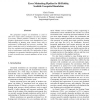Free Online Productivity Tools
i2Speak
i2Symbol
i2OCR
iTex2Img
iWeb2Print
iWeb2Shot
i2Type
iPdf2Split
iPdf2Merge
i2Bopomofo
i2Arabic
i2Style
i2Image
i2PDF
iLatex2Rtf
Sci2ools
CW
2006
IEEE
2006
IEEE
Error Minimising Pipeline for Hi-Fidelity, Scalable Geospatial Simulation
The geospatial category of simulations is used to show how origin centric techniques can solve a number of accuracy related problems common to 3D computer graphics applications. Previous work identified how poor understanding of floating point related issues lead to performance, architectural and accuracy problems. This paper extends that work by including time error minimisation, lazy evaluation and progressively refined fidelity and looks at performance trade-offs. The application of these techniques to a geospatial simulation pipeline is described in order to provide more concrete guidance on how to use them.
Accuracy Related Problems | CW 2006 | Distributed And Parallel Computing | Geospatial Simulation Pipeline | Origin Centric Techniques |
| Added | 10 Jun 2010 |
| Updated | 10 Jun 2010 |
| Type | Conference |
| Year | 2006 |
| Where | CW |
| Authors | Chris Thorne |
Comments (0)

